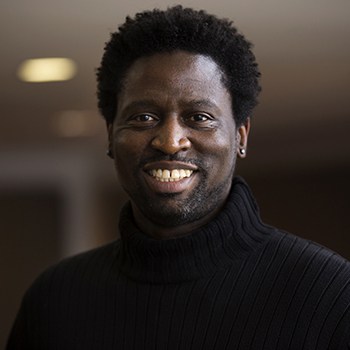Location
169 EWRE, 1351 Beal Avenue
Ann Arbor, Michigan 48109-2125
Phone
Primary Website
Education
- Ph.D. (Mechanical Engineering), University of California, Berkeley, Berkeley, CA, 1998
- M.S. (Mechanical Engineering), University of California, Berkeley, Berkeley, CA, 1997
- B.S. (Aeronautical & Astronautical Engineering), MIT, Cambridge, MA, 1987
Research Interests
Research focuses on reducing the environmental and health impacts of a variety of airborne aerosols. Current areas of activity include:
- Electrostatic precipitation of aerosols with particular interest in the coupling between the fluid and electric fields (i.e., electro-hydrodynamics);
- Non-Thermal plasmas as a means for inactivating airborne infectious agents such as viruses & bacteria in ventilation air;
- Aerosol optical properties, with emphasis on new emission sources of particulate carbon and potential contributions to atmospheric climate forcing and climate change;
- Air toxic compounds emitted from combustion processes and their control;
- Liquid droplet combustion, especially non-ideal behavior contributing to formation of products of incomplete combustion.
Research consists of laboratory experiments, numerical simulations and field studies as appropriate, involving both graduate and undergraduate researchers. This research has funding from and implications for both industrial clients and federal and international agencies tasked with addressing environmental hazards relating to air quality and the emission of air pollutants
Professional Service
Frontiers in Energy Research: Advanced Fossil Fuel Technologies
- Inaugural Associate Editorial Board member (2014-present)
International Society for Electrostatic Precipitation
- Member, Board of Directors (2013-present)
- Vice-President (2018-present)
National Academies, National Research Council
- Member, Committee on Changes in New Source Review Programs for Stationary Sources of Air Pollutants (2004-2006)
- Member, Committee to Examine the Disposal of Activated Carbon from the Heating, Ventilation, and Air Conditioning Systems at Chemical Agent Disposal Facilities (2008-2009)
- Member, Committee on Disposal of Legacy Nerve Agent GA and Lewisite Stocks at Deseret Chemical Depot (2009)
- Member, Committee to Review the Design of the Dynasafe Static Detonation Chamber (SDC) System for the Anniston Chemical Agent Disposal Facility (2010)
- Member, Board on Army Science and Technology committee Alternatives for the Demilitarization of Conventional Munitions (2017-2018)
- Member, Committee on Anticipatory Research for EPA’s Research and Development Enterprise to Inform Future Environmental Protection: The Road Ahead (2021- )
United Nations Environment Programme (UNEP), Global Mercury Partnership
U.S. Army Chemical Materials Agency/Advanced Chemical Weapons Alternatives (CMA ACWA)
- Member, Standing Advisory Committee on Chemical Demilitarization (2010-2016)
Awards
- Kenneth M. Reese Outstanding Research Scientist Award, University of Michigan College of Engineering (2019)
- Harry J. White Award, International Society for Electrostatic Precipitation (2013)
- Best Paper Award, “Computational Modeling of Electrohydrodynamically-Influenced Mercury Adsorption within ESPs”, 13th International Conference on Electrostatic Precipitation, 17-20 September 2013, Bangalore, India
- National Academies (U.S.)/Alexander von Humboldt Foundation (Germany)
- Invited topical review, German-American Frontiers in Engineering Symposium (2005)
- National Science Foundation
- Faculty Early Development (CAREER) Award (2004-2009)
- MIT Department of Aeronautics and Astronautics
- Sixteen Distinguished Young Alumni/ae (2000)
- National Academies, National Research Council
- Postdoctoral Fellow (1998-1999)
Publications
- Xia, T., A. Kleinheksel, E.M. Lee, Z. Qiao, K.R. Wigginton and H.L. Clack (2019). “Inactivation of airborne viruses using a packed bed non-thermal plasma reactor.” J. Phys. D: Appl. Phys. 52 255201, https://doi.org/10.1088/1361-6463/ab1466.
- Clack, H.L. (2018). “Lower Order Representations of Evolving Particle Size Distributions for Rapid Gas-Particle Mass Transfer Simulations during Electrostatic Precipitation.” Fuel Processing Technology 178, 71-77 .
- Xia, T. and H.L. Clack (2017). “Optical Property Measurements of Mixed Coal Fly Ash and Particulate Carbon Aerosols Likely Emitted During Activated Carbon Injection for Mercury Emissions Control.” Energy & Fuels 31, 11791-11803.
- Clack, H.L. (2017). “Simulation of Electro-hydrodynamic Phenomena and Their Influences on Particulate Collection and Trace Pollutant Adsorption within Electrostatic Precipitators.” Frontiers in Energy Research: Advanced Fossil Fuel Technologies, doi: 10.3389/fenrg.2017.00003 (Electronic ISSN: 2296-598X).
- Clack, H.L. (2017). “Inhibition and Promotion of Trace Pollutant Adsorption within Electrostatic Precipitators.” Journal of the Air & Waste Management Association 8, 881-888.
- Clack, H.L. “Opportunities for Post-Combustion Control of Mercury Emissions from Coal Combustion.” In: Mercury in Coal and its Energo-Chemical Processing Products (translated from the Polish), J. Golas and A. Strugala, eds., 2013.
- Clack, H.L. (2012). “Estimates of Increased Black Carbon Emissions from Electrostatic Precipitators during Powdered Activated Carbon Injection for Mercury Emissions Control.” Environmental Science and Technology 46 (13), pp 7327–7333.
- Ammigan, K., R.M. Miller, and H.L. Clack (2012). “Effect of Asymmetric Radiant Heating on Monodisperse Acetone-Ethanol and Acetone-Isopropanol Bicomponent Droplets.” International Journal of Multiphase Flows 38, 67-72.
- Prabhu, V., T. Kim, Y. Khakpour, S. Serre, and H.L. Clack (2012). “On the Electrostatic Precipitation of Fly Ash-Powdered Mercury Sorbent Mixtures.” Fuel Processing Technology 93, pp. 8-12.
- Ammigan, K., R.M. Miller, and H.L. Clack (2011). “Vaporization of Multicomponent Droplets Exposed to Radiant Heating.” Combustion Science & Technology 183, 1412-1432.
- Lee, E.M. and H.L. Clack (2010). “In situ detection of altered particle size distributions during simulated powdered sorbent injection for mercury emissions control.” Energy & Fuels 24, pp. 5410-5417.
- Clack, H.L. (2009). “Mercury Capture within Coal-fired Power Plant Electrostatic Precipitators: Model Evaluation.” Environmental Science and Technology 43, pp. 1460-1466.
- Scala, F. and H.L. Clack (2008). “Mercury Emissions from Coal Combustion: Modeling and Comparison of Hg Capture in a Fabric Filter versus an Electrostatic Precipitator.” Journal of Hazardous Materials 152, pp. 616-623.
